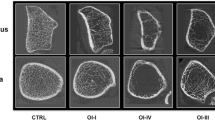Abstract:
The objectives of this study were (1) to determine whether there are differences in bone density in children versus adults with osteogenesis imperfecta type I (OI-type I) using computed tomography (CT) bone density measurements, (2) to determine whether there are differences in bone density between normal infants and infants with OI-type I using CT bone density measurements and (3) to determine whether CT bone density measurements could be helpful in investigating the infant with unexplained fractures. CT bone density measurements determine both the cortical bone density (CBD) and the trabecular bone density (TBD). CT bone density was determined using the OsteoQuant in 14 individuals with OI-type I who ranged in ages from 8 months to 45 years. The control groups consisted of over 1000 normal individuals, mostly adults, and included 7 normal infants who ranged in age from 10 months to 27 months. One of the individuals with OI-type I was a 4-month-old infant with multiple, unexplained fractures who had no other features of OI-type I and whose parents were accused of child abuse. Infants and children with OI-type I had low CBD and low TBD compared with normal controls, whereas adults with OI-type I had low TBD and high CBD when compared with controls. The one infant with multiple unexplained fractures and no other features of OI-type I had a bone density profile suggesting OI-type I with a low TBD and low CBD. Subsequent collagen analysis showed biochemical evidence of OI-type I. Individuals with OI-type I have abnormal CT bone density profiles that evolve over time from a low CBD and low TBD during infancy and childhood to a high CBD and low TBD during adulthood. This may explain the decreased frequency of fractures in individuals with OI-type I in adulthood compared with childhood. Individuals with OI-type I can present with only multiple unexplained fractures and have no other clinical features to strongly suggest the diagnosis. CT bone density measurements can be helpful in these atypical cases of OI-type I and should be considered in the investigation of the infant with unexplained fractures to help distinguish intrinsic bone disease from child abuse.
Similar content being viewed by others
Author information
Authors and Affiliations
Additional information
Received: 19 May 1998 / Accepted: 23 September 1998
Rights and permissions
About this article
Cite this article
Miller, M., Hangartner, T. Bone Density Measurements by Computed Tomography in Osteogenesis Imperfecta Type I . Osteoporos Int 9, 427–432 (1999). https://doi.org/10.1007/s001980050167
Issue Date:
DOI: https://doi.org/10.1007/s001980050167




